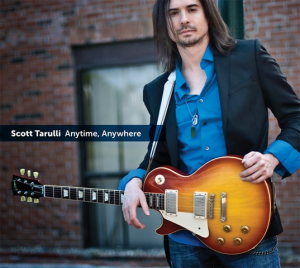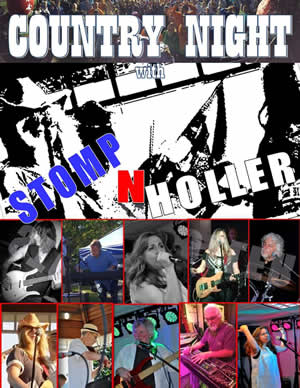 Scott Tarulli’s latest instrumental album Anytime, Anywhere is marked by the guitarist’s usual high level performance and technique. Listening to Tarulli carefully, though, reveals a gift for emotional expression, a use of colors, tones, and themes that are equally impressive. Each composition is a flight of fancy that tells a story and paints a picture with nuanced touches among the styles and techniques Tarulli utilizes. It is uncanny how this player can infuse his tasteful phrases with fanciful technique without showing off but rather calibrates each note carefully and tenderly to serve his compositions.
Scott Tarulli’s latest instrumental album Anytime, Anywhere is marked by the guitarist’s usual high level performance and technique. Listening to Tarulli carefully, though, reveals a gift for emotional expression, a use of colors, tones, and themes that are equally impressive. Each composition is a flight of fancy that tells a story and paints a picture with nuanced touches among the styles and techniques Tarulli utilizes. It is uncanny how this player can infuse his tasteful phrases with fanciful technique without showing off but rather calibrates each note carefully and tenderly to serve his compositions.
“Path I” is an alluring electronic sound effect that segues into “Awake,” a number marked by a lot of sweet melodic intervals that eventually get swapped out for heavier, grunge-like, dark shadings. Tarulli gets a sublime high-pitched phrase going on that impresses for its timing and sharpness. Then, he bangs out some hefty, crunchy chords that tightly punctuate his lighter phrases.
“Shade Dance” too finds Tarulli playing sharp precise melodic lines as well as informing his chord structure with darker colors. It’s like listening to the auditory equivalent of an old film noir classic in which every scene, set piece, costume, and shadow were designed to play with the black and white cinematography. Tarulli is quite comfortable taking his listeners into and out of the lighter and darker shades. He leads us in along his journey into colors and tones, and he rewards us with his fine playing, each section of a song sounding like something special in its own right as well as part of a longer narrative arc. Dennis Hughes plays an electric keyboard melody that suggests he listened to a lot of 1970s fusion like Return To Forever. His piano backdrop is a space age kaleidoscope of melodic notes that majestically change with colors of the piece.
Alison Keslow leads us into track four, “Traffic,” with her ever so present if understated low end line. Over this smooth, deep line, Tarulli only need come in with a self-restrained edge and skate freely over the surface of that low end. The guitarist, in places, infuses the piece with a sense of urgency, his phrase whistling with precision and forcefulness until he lets Hughes, who composed this number, take over the main melodic duties with his tasteful tinkling of the ivory keys. Not only do Tarulli and his support players conjure a feeling of busy and constantly shifting traffic, they do it with style. There is a jazzy freedom here that elevates this work into a meta-cognitive reflection on traffic as it takes the listener through traffic.
“One Year” plays out in a chill vibe. Tarulli cools the pace but not his expression. Playing with colorful, tuneful melodic lines, he presses gentle phrases from his instrument that feel surely like they’re coming from his heart. A true musician and artist, Tarulli tells tales, paint pictures, and just lets the feeling flow. Judging by the title, “One Year,” must be marking a significant anniversary in the artist’s life. The multi-dimensional colors and tones from his guitar and Dennis Hughes organ indicate he went on quite a journey that year.
“Path II” is another spacey sound effect segue, bringing the listener right into “Caffeine And Wine.” Here, the artist keeps switching his tempos and tones to indicate portions he wrote under the calming influence of a glass of wine with manic portions he wrote under the frantic, nervousness that comes from caffeine. His gentle portions are almost dreamy in their soft lift and he doesn’t drink the cheap stuff, based on the classy phrasing he does here. Tarulli’s soothing melodic line hums with self-restraint. Then, he suddenly slams out thicker chords and a mightier phrase before, with his masterful touch, returns to a slightly edgier version of the main melody line. Only a player with Tarulli’s kind of control can take two diametrically opposed tempos, colors and tones, and feel, and fuse them both tightly into one work.
“Aurora,” written by Alison Keslow, feels a bit like classic rock in its tighter framework while within that structure the listener is treated to a jazzy, freewheeling, loosey-goosey approach in the melodic lines. Tarulli presses out a persistently sharp line that evolves into a wider embrace of the understated rhythm around him. An initial listening may only make a listener think, “Hey, this is really cool” because the guitar has that smoky rock edge to it. Repeated listening, however, reveal even more depth. Tarulli is unfurling a head full of thought and a heart full of emotion. The inspiration for his playing in this particular piece came from a serious source.
“Last Time” commences with soft touches on Tarulli’s electric that reach tenderly into the soundscape. It’s as delicate a baby’s gripping fingers when he expresses himself both on electric and acoustic. Interestingly enough, rock star bass player Tony Levin(Peter Gabriel, John Lennon, King Crimson) holds down the low end here. Levin plays the smoothest of bass lines with just enough presence to be felt but he mainly conjures something that allows the melody to arc over him. The piece just hums along with true musical beauty, and that is what works well for Tarulli. He uses the modern styles and instrumentation to paint a picture that is larger than just a genre label. He makes you feel what he was feeling when he composed these pieces and that is more important to any artist than the techniques he used to get there.
“1 AM” is a bit funkier than the rest of Tarulli’s album. Drummer Jerry Marotta keeps it feisty with that little extra something he hits in between the beats. Here, Tarulli and his guitar go toe to toe with Ross Hill’s violin and Flugelhorn, acting and reacting in a sweet dance of melody. The lead guitar winds it way around the lively drum smacks at a pleasant cruising speed then quietly gives way to that flugelhorn bliss.
Tarulli closes out his album with “One Year “Reprise,” sharing the spotlight with saxophonist Mindi Abair. Abair starts her phrase with the kind of energy most sax players work toward as the momentum builds near the end. The horn’s take on the melody provides the number with a whole different exuberance than the previous version. It is a brief number but lets the album finish with a flourish of bright brassiness.
Tarulli has much to be proud of on Anytime, Anywhere. He not only delights and impresses the ear with his playing, he informs the heart and soul with his personality inside these compositions.

